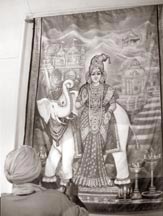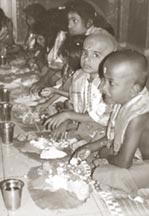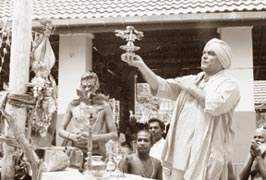|
| |||||||||||||||||||||||||||||||
Kataragama Tevayani Amman Temple:
|
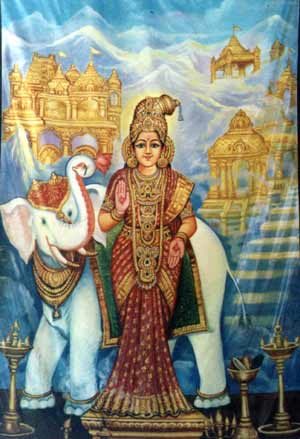
|
| Goddess Teyvanai Amman (Skt. Devasenā), Lord Murugan's spouse and presiding deity of Teyvanai Amman Kovil, Kathirkamam. (Temple curtain at Kathirkamam, 2001) |
By Swami Vigyananand and Patrick Harrigan
(Colombo: The Daily News of Wednesday July 24, 2002)
Historically Tevayani Amman (Sanskrit: Devasenā) and her traditions hail from North India where they are associated with Hindu monks of the Dāsanāmi Order founded by Adi Sankaracharya in the 8th Century AD. Myth and history combine to explain how Thevayani Amman came from North India to Kataragama to recover her wayward husband Lord Murugan.
Centuries ago, it is believed, the Kataragama God's senior spouse Tevayani Amman prompted Kalyana Giri Swami to leave North India and come South to find her missing husband and bring him home.
The sage is said to have found Lord Murugan in Kataragama. Kalyana Giri Swami requested Lord Murugan to accompany him to India, but Valli Amma intervened and begged Kalyana Giri Swami not to take her husband away. Kalyana Giri Swami never returned to India but remained and requested Thevayani Amman to come and settle in Kataragama also. Thevayani Amman came and since that time all three deities live happily together in Kataragama.
![Flag-hoisting at Teyvanai Amman Kovil [12 kb]](../pix/teyvanai_kodiyetram1.jpg) |
Flag-hoisting at Teyvanai Amman Kovil |
![Teyvanai Amman Matadipathi and devotees [12 kb]](../pix/teyvanai_kodiyetram2.jpg) |
| Former Teyvanai Amman Mathadhipati the late Dattārāmagiri Swamigal and devotees, 1994 |
Kalyana Giri Swami then founded Thevayani Amman Devasthanam. The North Indian Dasanami succession has continued unbroken to this day. Kalyana Giri Swami thus became the founding abbot or mathadhipati of Kataragama Thevayani Amman Devasthanam. Since that time the succession of North Indian Dasanami mathadhipatis has administered the Math and associated temples.
Over the centuries, annually thousands of sadhus and saints from India used to walk from Jaffna to Kataragama and stay in the vicinity of Thevayani Amman Devasthanam. Nowadays, however, modern visa and passport restrictions have all but stopped this holy tradition linking peoples of the subcontinent. Yet, to this day, thousands of Sri Lankan pada yatra pilgrims and a handful of Indian sadhus and European pilgrims still continue to walk by the same coastal route.
Thanks to the restoration of peaceful conditions throughout the island, this year pilgrims assembled and walked from Vattappalai Kannaki Amman Temple in Mullaitivu District for the first time in decades. From 2003 the Pada Yatra pilgrims expect to resume walking from Jaffna peninsula again as per the ancient tradition.
Thousands of pada yatra pilgrims of all ages, communities and walks of life join in this holy karai yatra or coastal pilgrimage. All are received with respect and served annadanam by villagers all along the route.
The rituals performed at all the temples of Kataragama may be traced to the Adinath Sampradaya of the great Saiva sect temple at Gorakhpur established in North India by the great siddha master Gorakhnath. Arathi puja and the tying of the mouth shut are a few examples of Kataragama traditions hailing from North India.
This ancient institution also has had modern legal recognition thanks to Śrī Maharaj Kesopuri Swami. Better known as Pal Kudi Baba, the great yogi saint founded the Thevayani Amman Temple Trust shortly before his samadhi in 1898. He exclusively specified in his trust deed that only Dasanami sannyasi parampara shishya of Bhagavan Dattatreya may be appointed as Mathadhipati and Trustee. The samadhis of these great saints may be visited behind the Guru Asanam.
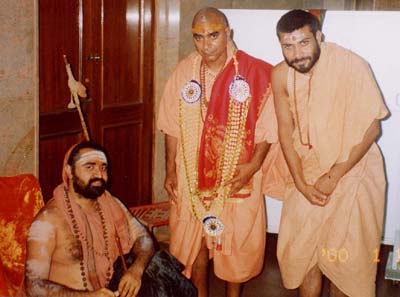
|
| HH Kanchi Sankaracharya (seated at left) appointed Pūrnānand Giri Swami (center) as Mathadhipati and Vigyānānand Ashram Swami (right) as Deputy Abbot of Kataragama Teyvanai Amman Math in January 2000. |
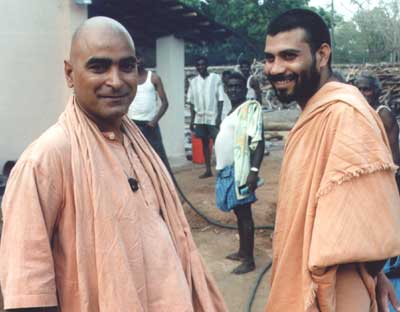
|
| Mathadhipati Pūrnānand Giri Swami (left) and his deputy Vigyānānand Ashram Swami direct the Temple's large-scale cooking operation during the 2001 Esala festival. |
After the departure of the former mathadhipati Dattarama Giri Swami, devotees felt the absence of a mathadhipati and trustee began to clamour for fresh appointment. His Holiness Jagatguru Sankaracharya of Kanchi Kamakoti Peetham Śrī Jayendra Saraswati Mahaswamigal personally appointed a highly qualified North Indian Dasanami sannyasi, Purnanand Giri Swami (49) as Trustee and Mathadhipati along with a junior associate of the same lineage to assist in the smooth operation of the Devasthanam, thereby preserving the Dasanami succession of administrators.
The resonant voice of the gifted and vigorous new mathadhipati now fills the kovils and matham once again to the delight of Tamil and Sinhala devotees, despite the fact that he is fully conversant in Hindi, Sanskrit and English only.
|
|
Among recent changes to the infrastructure of the institution, notable are the complete renovation and refitting of the annadanam hall with a sturdy new roof, ceiling fans and sanitary floor tiles. Devotees note that sanitary standards as well as the quality of food and service have improved substantially in the past two years. Moreover, the devotees now feel more welcome and well cared for thanks to institutional changes initiated by the new Mathadhipati Purnanand Giri Swami.
Annadanam for the devotees is served in the traditional fashion of Tamil Hindus with devotees seated on the tile floor taking meals from plantain leaves. Annadanam is also served to devotees daily year round and to the public every Friday outside of the festival season. During the festival season, thousands of devotees and public receive annadanam regardless of community, wealth or social status.
The Devasthanam has also been taking all necessary measures to save precious water and firewood. To alleviate the frequent shortages of drinking water and to maintain sanitation, in 2002 a deep tube well was drilled within the compound. To save firewood, the Mathadhipati introduced traditional North Indian technology of fuel-saving underground stoves for the quick and efficient preparation of large quantities of cooked food.
|
|
Not only Tamil Hindus alone but devotees of all communities, rich and poor alike, come in droves to avail themselves of the matham's tasty vegetarian meals, including wealthy urban devotees, pada yatra pilgrims, mothers with children, swamis, sadhus, fakirs and service personnel of the security forces.
|
|
Over the centuries, many great souls like Kriya Yoga Babaji and Palkudi Baba have been associated with the sacred setting of Teyvani Amman Temple. The Temple Trust has recently consecrated a shrine built upon the site where the master siddha Kriya Yoga Babaji -- well known as Maha Avatar Kriya Babaji -- sat in meditation under a great banyan tree many centuries ago as directed by his guru Bhogar Siddhar.
The historic tradition of Flag-Hoisting Ceremony at Kataragama Teyvani Amman Temple takes place on the sixth day of the Esala (Adi) festival. The Mathadhipati and Trustee Purnanand Giri Swami conducts this ritual precisely according to scriptural injunction in which the saffron flag is first sanctified and then hoisted with full honours as a special occasion for Hindus to celebrate their role in the festival. On the same day Purnanand Giri Swami also conducts a flag-hoisting ceremony at the Muttulinga Ishwara (Siva) Temple.
Another important and joyous occasion is the annual Ambal Darshan of the Devasthanam's presiding deity Śrī Theyvani Amman with her associated rituals. Once only in a year, Devi gives darshan, so her devotees attach great importance to this event, which also coincides with the Maha Perahera of Lord Kathirkama Kanthan. All night long Devi gives darshan and blesses Her devotees.
As an ongoing tradition of Theyvani Amman Devasthanam, annually annadanam is prepared and offered twice daily on a mass scale for thousands of pilgrims, devotees and duty personnel of all communities during the Adi festival. This occasion is an exceptional opportunity to serve Lord Murugan, Valli, Theyvani Amman and their devotees throughout the festival.
In the future also, with the support of earnest devotees, the Matham intends to uphold its ancient tradition of annadanam served here at Theyvani Amman Devasthanam in devotional service to Lord Murugan and His devotees.
Recently Purnanand Giri Swami also renovated the old Konkattiya Matham in the jungle near Buttala where the pada yatra pilgrims used to halt. Similarly, much more work yet remains to be done under the leadership of Mathadhipati and Trustee Purnanand Giri Swami. The Hindu community is especially proud to see the ancient glory of Thevayani Amman Devasthanam being restored before their eyes in the 21st Century.
For a detailed history of Kataragama Theivanai Amman Temple, download A Short History of Kataragama & Theivanai Amman Thevasthanam by Selvam Kalyanasunadaram (1980, 42 pp.)
This article also appears in the online edition of The Ceylon Daily News.
See also this article on Hindu Temple Worship by HH the Kanchi Sankaracharya.
Important Esala 2011 festival dates
| Ceremony | Natchathram | Date |
| Main Flag-hoisting at Mosque | Punar Pusam natchathram | 1 July |
| Teyvanai Amman Flag-hoisting | Atham natchathram | 7 July |
| Maha Perahera & Ambal Darshanam | ādi paurnami | 14 July |
| Water-cutting Ceremony (Teertham) | Thiruvona natchathiram | 15 August |
For more information about Teyvayanai Amman Kovil and Matham, e-mail to D.M. Swaminathan dmswaminathan@gmail.com.
Theivani Amman Devasthanam home page | Kalyanagiri and the Kalyana Mandapa
The life of Pal Kudi Bawa of Kathirkamam | Annadanam from Kailasa to Kataragama | Kriya Babaji and the ancient Kataragama shrine
|
